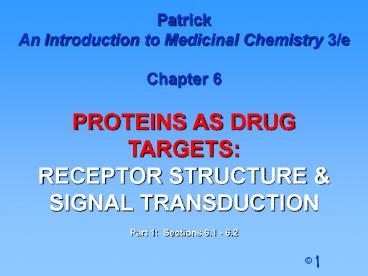Patrick - PowerPoint PPT Presentation
Title:
Patrick
Description:
traversing cell membrane. Messenger. Receptor. INDUCED. FIT. GATING' (ion channel. opens) Cationic ion channels for K , Na , Ca2 (e.g. nicotinic) = excitatory ... – PowerPoint PPT presentation
Number of Views:166
Avg rating:3.0/5.0
Title: Patrick
1
Patrick An Introduction to Medicinal Chemistry
3/e Chapter 6 PROTEINS AS DRUG
TARGETS RECEPTOR STRUCTURE SIGNAL
TRANSDUCTION Part 1 Sections 6.1 - 6.2
2
- Contents
- Part 1 Sections 6.1 - 6.2
- 1. Receptor superfamilies
- 2. Ion channel receptors (Ligand gated ion
channels) - 2.1. General structure (3 slides)
- 2.2. Structure of protein subunits (4-TM
receptor subunits) - 2.3. Detailed structure of ion channel
- 2.4. Gating (2 slides)
- 9 slides
3
1. Receptor superfamilies
- ION CHANNEL RECEPTORS
- G-PROTEIN COUPLED RECEPTORS
- KINASE LINKED RECEPTORS
- INTRACELLULAR RECEPTORS
4
2. Ion channel receptors (Ligand gated ion
channels)
2.1 General structure
Five glycoprotein subunits traversing cell
membrane
Cationic ion channels for K, Na, Ca2 (e.g.
nicotinic) excitatory Anionic ion channels for
Cl- (e.g. GABAA) inhibitory
5
2. Ion channel receptors (Ligand gated ion
channels)
Transverse view (nicotinic receptor)
2xa, b, g, d subunits
6
2. Ion channel receptors (Ligand gated ion
channels)
Transverse view (glycine receptor)
3xa, 2x b subunits
7
2. Ion channel receptors (Ligand gated ion
channels)
2.2 Structure of protein subunits (4-TM
receptor subunits)
4 Transmembrane (TM) regions (hydrophobic)
8
2. Ion channel receptors (Ligand gated ion
channels)
2.3 Detailed structure of ion channel
Note TM2 of each protein subunit lines the
central pore
9
2. Ion channel receptors (Ligand gated ion
channels)
2.4 Gating
10
2. Ion channel receptors (Ligand gated ion
channels)
2.4 Gating
- Fast response measured in msec
- Ideal for transmission between nerves
- Binding of messenger leads directly to ion flows
across cell membrane - Ion flow secondary effect (signal transduction)
- Ion concentration within cell alters
- Leads to variation in cell chemistry





![[PDF READ] Free Not a Number: Patrick Mcgoohan - a Life PowerPoint PPT Presentation](https://s3.amazonaws.com/images.powershow.com/10079044.th0.jpg?_=20240716034)

















![READ⚡[PDF]✔ PATRICK DEMPSEY: The Iconic Biography of Hollywood Actor who starred in Grey's PowerPoint PPT Presentation](https://s3.amazonaws.com/images.powershow.com/10062859.th0.jpg?_=20240624072)







